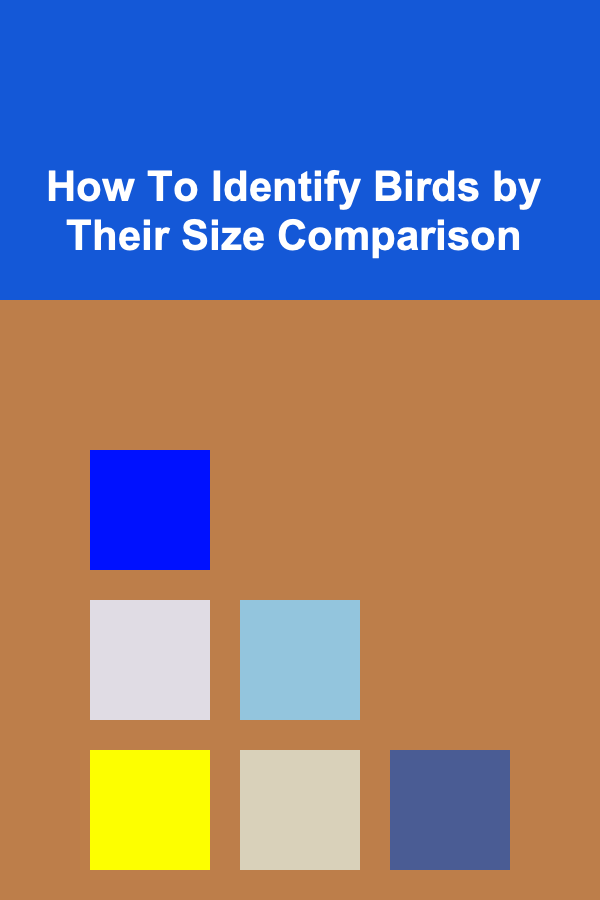
How To Identify Birds by Their Size Comparison
ebook include PDF & Audio bundle (Micro Guide)
$12.99$11.99
Limited Time Offer! Order within the next:

Birdwatching is a popular hobby for many people around the world. Whether it's observing rare species in the wild, identifying common backyard birds, or simply enjoying the beauty of our feathered friends, birdwatching brings a deep sense of connection to nature. One essential skill in bird identification is size comparison. While field guides and online resources offer extensive lists of physical features and descriptions, comparing the size of birds in relation to one another can provide a helpful shortcut for identification. In this article, we'll explore how to identify birds using their size comparison and how this technique can enhance your birdwatching experience.
Understanding the Importance of Size in Bird Identification
Bird size plays a crucial role in identifying species. Just like mammals, birds come in a wide range of sizes, from the tiny hummingbird to the large, majestic ostrich. Knowing the size of a bird can often eliminate potential misidentifications, particularly when you're dealing with similar species that share other characteristics like coloration or shape.
However, size comparison isn't as simple as just knowing the bird's height or weight. Size comparison is typically done by measuring a bird's length, wingspan, and sometimes its weight. These metrics help provide a clear perspective on the bird's overall stature relative to other species. To get the most accurate size comparison, it's essential to observe a bird in relation to its environment and other creatures that might be nearby.
The Basics of Bird Size Measurement
Before diving into how to compare the sizes of different birds, it's essential to understand the main criteria used for bird size:
- Length: Length refers to the overall measurement of the bird from the tip of the beak to the tip of the tail. It's a standard metric used by ornithologists to measure and describe birds.
- Wingspan: Wingspan is the distance between the tips of a bird's wings when they are fully extended. It can provide an important clue for identifying a bird species, especially if you are dealing with birds that have similar body shapes.
- Weight: Although less commonly used for field identification, a bird's weight can sometimes be a useful indicator when comparing species, especially for larger birds or when observing birds from a distance.
- Body Shape and Proportions: Although not a direct measurement of size, the bird's body shape and proportions (such as the size of the head compared to the body) can provide additional context to its size.
How to Compare Bird Size
The process of comparing bird size involves two main strategies:
- Relative Comparison: This involves comparing the size of one bird to another bird whose size is already known. For example, you might compare the size of a bird to a crow, which is a common and easily recognizable species. If you spot a bird that looks similar in size to a crow, you can be fairly certain that it's in the same size range.
- Using Environmental Features: Environmental factors can offer valuable clues about the size of a bird. For example, comparing the size of a bird to nearby objects, such as trees, posts, or buildings, can help gauge its overall size. If you see a bird perched on a fence, you might compare it to the height of the fence, giving you a rough estimate of the bird's size.
Let's take a deeper look at both of these techniques and how to apply them effectively.
Relative Comparison: Using Known Birds as Reference
One of the most effective methods for identifying birds by their size is relative comparison. In this approach, you use a bird of known size as a reference point and compare it to the bird you're observing. This method is particularly helpful when you don't have a ruler or measuring tool at hand.
Here are some common birds used as size references:
1. The American Robin (Turdus migratorius)
The American Robin is a familiar bird in North America, with an average length of about 10 inches (25 cm) and a wingspan of 12-16 inches (30-40 cm). Its medium size makes it a great reference for comparison with other birds. When observing a bird that seems similar in size to the robin, you can reasonably conclude that it belongs to a medium-sized species.
2. The European Starling (Sturnus vulgaris)
The European Starling is another bird of moderate size. It is roughly 8-9 inches (20-23 cm) in length with a wingspan of 16-22 inches (40-56 cm). Its sleek, compact build makes it easy to compare with other small to medium-sized birds.
3. The House Sparrow (Passer domesticus)
The House Sparrow is one of the most common birds in urban and suburban areas. At around 6-8 inches (15-20 cm) in length, it is smaller than the robin and the starling. If you see a bird of similar size, you may be looking at a sparrow or another small passerine species.
4. The Crow (Corvus spp.)
Crows are among the largest songbirds, with an average length of 17-21 inches (43-53 cm) and a wingspan of 33-39 inches (85-100 cm). If you encounter a bird with similar dimensions to a crow, it could very well be another member of the crow family, like a raven, or possibly an eagle or hawk.
5. The Bald Eagle (Haliaeetus leucocephalus)
For much larger birds, you can use the Bald Eagle as a reference point. It has an impressive wingspan of 6-7 feet (1.8-2.1 meters) and can measure up to 40 inches (102 cm) in length. When comparing large birds, especially birds of prey, identifying species by their size relative to the Bald Eagle can often give you a good indication of the bird's identity.
6. The Hummingbird (Family: Trochilidae)
On the opposite end of the size spectrum, hummingbirds are among the smallest birds in the world, measuring only about 3-5 inches (7-13 cm) in length. They are useful for size comparison when dealing with small birds. If you spot a bird that appears similar in size, it's likely to be a small, nectar-feeding species.
Using Environmental Features to Gauge Size
When direct comparisons with known birds are not possible, you can rely on the environment to help you estimate a bird's size. This technique involves assessing the bird in relation to other objects, such as:
1. Tree Size
If a bird is perched on a tree branch or flying near trees, you can estimate its size by comparing it to the tree's branches or trunk. For example, if you see a bird near a pine tree, you can estimate the bird's length by comparing it to the width of the tree branches. Larger birds, like hawks or vultures, will appear much larger than smaller birds like sparrows or warblers.
2. Buildings or Utility Poles
Birds that perch on buildings or utility poles offer another great opportunity for size comparison. Utility poles are often standard in height, and a bird's size can be estimated by how it relates to the pole. For example, if a bird is perched on a utility pole and it appears to be much larger than the pole, it could be a bird of prey, like a red-tailed hawk or an owl.
3. Human Figures
In some cases, birds may be seen in close proximity to humans, either perched near people or flying overhead. By comparing the bird's size to the human figure, you can get an estimate of its dimensions. For example, if a bird appears to be as long as a person's arm, it might be a medium-sized bird like a pigeon or dove.
4. Other Animals
Comparing a bird's size to that of other animals, such as dogs, cats, or livestock, can also help in gauging its size. For instance, if a bird appears to be roughly the same size as a small dog, you might be looking at a bird like a crow or a kestrel.
Other Tips for Size Comparison
1. Flight Style and Posture
The way a bird flies or stands can also give you clues about its size. Large birds, like eagles or vultures, often have a slower, more deliberate flight pattern. Smaller birds, like sparrows or warblers, have faster, more erratic flight movements. Additionally, the posture of a bird when perched can indicate its size. Larger birds tend to have more upright, solid postures, while smaller birds might perch with their bodies hunched or in a more relaxed position.
2. Age and Gender Differences
In some species, males and females can differ in size. For example, in raptors like hawks and owls, females are typically larger than males. Similarly, young birds may appear smaller than adults. Keep these factors in mind when comparing size; differences in age and gender can influence a bird's overall dimensions.
3. Seasonal Variations
Size can also vary depending on the season. Birds tend to put on weight before migration, so a bird that seems larger than usual during the fall could be preparing for its journey. Similarly, some birds may have different plumage or appear larger during breeding season.
Conclusion
Bird identification can be a complex and rewarding process, and size comparison is one of the most effective techniques to help you pinpoint the species you're observing. By learning to compare birds relative to well-known species, using environmental features to gauge size, and considering factors like posture, flight style, and seasonal changes, you can become more adept at identifying birds on your next birdwatching adventure. Understanding how to evaluate a bird's size can make all the difference when trying to spot and identify new species in the field.

How to Organize Your Kitchen Drawers for Better Functionality
Read More
How to Refinish Your Furniture During a Home Renovation
Read More
How to Set Up a Technology Help Session for Seniors
Read More
How to Utilize Travel Hacking to Save Money and Make Your Travels Profitable
Read More
Mastering the Detail Brush: Cleaning Tight Crevices with Precision
Read More
How to Create an Estate Planning To-Do List for Digital Assets
Read MoreOther Products

How to Organize Your Kitchen Drawers for Better Functionality
Read More
How to Refinish Your Furniture During a Home Renovation
Read More
How to Set Up a Technology Help Session for Seniors
Read More
How to Utilize Travel Hacking to Save Money and Make Your Travels Profitable
Read More
Mastering the Detail Brush: Cleaning Tight Crevices with Precision
Read More